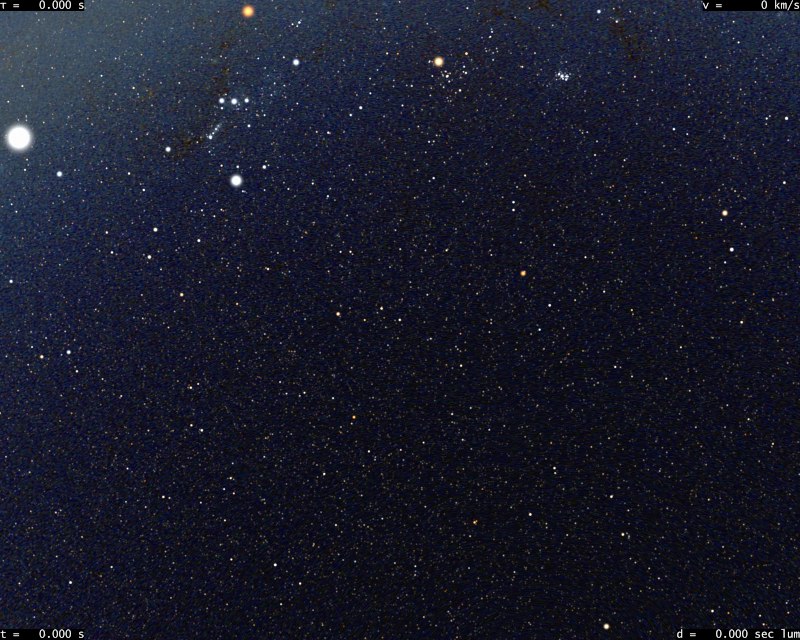Black holes, Interstellar, etc.
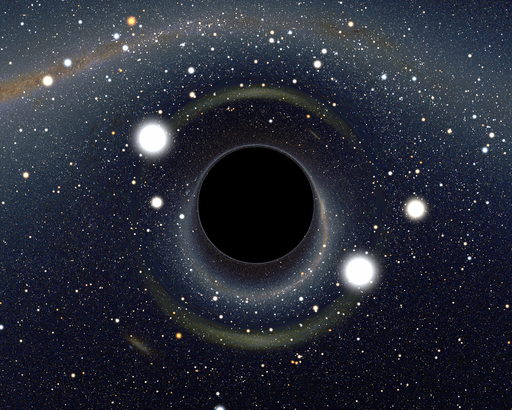
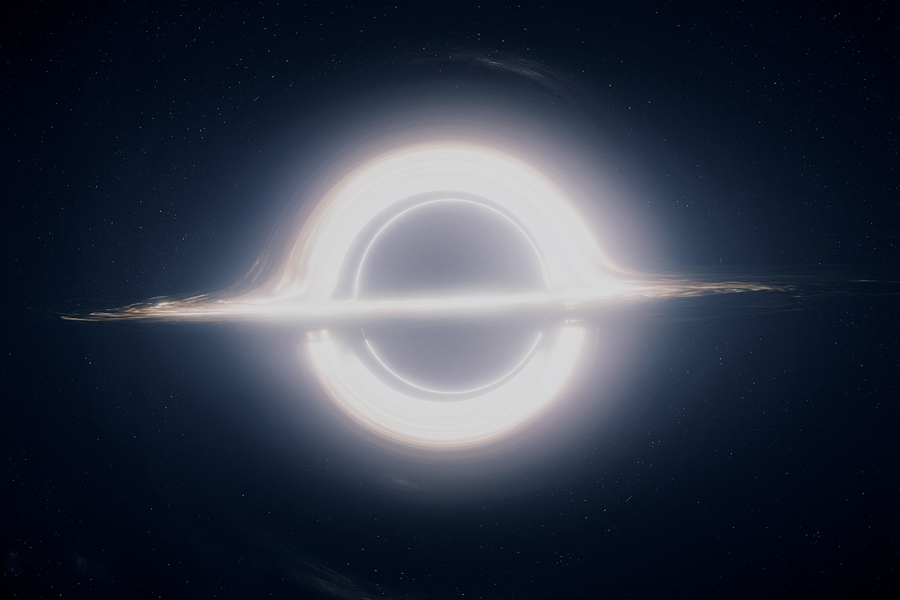
Two black holes, with different properties, shown with
different rendering choices. Left picture is mine, right is
from Interstellar, courtesy of Warner Bros.
Entertainment Inc..
Disclaimers
- I have been in contact with M. Kip Thorne during the
preparation of the Interstellar movie. M. Thorne knew
about some movies I had made some years ago (for outreach
purpose) showing as realistically as possible what black holes
looked like in certain conditions. The possibility that I
could become actively involved in the production of the
film visual effects was considered at some point, but this was
not done in the end. Apart from some informal email exchanges
with M. Thorne (which, hopefully, were useful to him), I have
not been involved in the movie.
- This page and the other ones here are, I think,
spoiler-free.
- Some of the videos linked here are pretty big. If you
experience problems, try using the VLC software.
- In case you intend to use some of the material found here,
plase, credit me accordingly (A. Riazuelo, IAP/UPMC/CNRS).
What would we see when orbiting around a black
hole?
A black hole is a region of space that is able to
prevent anything, even light, from escaping. Such a region is
therefore, by construction, completely black, but its silhouette
can be seen it there is some light source that can delineate it.
In the Interstellar movie, the light source is the black
hole accretion disk, i.e., the light emitted by some matter that
is orbiting around the black hole. As it orbits around, friction
between between disk particles produce some heat, which make the
particles slowly spiral toward the black hole, and, more
importantly here, produce some light is sufficiently large amount
so as to be seen. Actually, such an accretion disk can be
extremely hot and thus emits a large amount of visible light and
an even larger amount of X-rays. Such an active disk would a be
deadly to witness by any living being. The accretion disk that is
depicted in the Interstellar movie is therefore in an
unusually non active state, or, in astrophysicists' vocabulary, in
a quiescent state. In what follows, we choose to remove the disk
completely (since such a quiescent state may be physically
possible but very unusual), and to somewhat increase the celestial
sphere luminosity. This is sufficient to delineate very accurately
(at least as accurately as in the movie, I would say), the black
hole silhouette. In practice, the celestial sphere shows around
200,000 stars, which is quite a lot as compared to the few
hundreds of stars that we see in urban areas, or the few thousands
that we can see away from any significant light sources.
Going fast
Unless we can spend huge amounts of energy, it
is not possible to be at rest close to a black hole: the thrust we
would need to make in order to counterbalance the black hole
gravity would be too large by an incredibly huge amount.
Therefore, we need to orbit the black hole if we want to make
something realistic. But since gravity is huge close to the black
hole, he centrifugal force originating from our orbital motion
must also be huge, and since the black hole distance is small, our
orbital velocity will be very large. Now, forgetting about the
black hole, a large velocity (whether or not orbital) does in
itself induce several optical phenomena. The most well-known (but
actually the least important) is the Doppler shift: a green light
source will appear bluer for an approaching observer, and redder
for a receding one. But there are some least known although more
important phenomena to be taken into account. The photon flux is
always greater when one approaches a light source, because one has
to wait less time between consecutive photons. Therefore, the
approaching observer will experience a brighter flux than a
receding one. Finally, it is well-known that when one drives a car
as rain is falling, the apparent direction of the water droplets
as seen from within the car change with the car velocity, in the
sense that the faster the car goes, the more horizontally the
water droplets seem to fall. In other words, water droplet seem to
originate form a direction that is all the more close to the
direction of motion that the car velocity is large. For the very
same reasons, such effect, called aberration, also exists for
light. This means that
the faster you move, the more the
landscape you are heading to will shrink. This is very
counterintuitive! Here are a few pictures:
Let us start from an observer a rest, looking at the sky we are
familiar to.
Amateur astronomer will recognize, on top from
left to right, Sirius, Orion, Taurus and the Pleiades cluster. We
have significantly enhanced eye sensitivity here, so that we can
see (much) more stars, as well as their actual colors, but all is still familiar here. We are
going to accelerate from rest to 99.5% of the speed of
light. Such acceleration is either very long, or very
dangerous! If you assume a constant acceleration a, then
the time t to get close to the speed of light, c
is such that the quantity a t / c is
greater than but of order of 1. If your acceleration is of order of
Earth surface gravity, then t is several years, and if you
want t to be of order of a few minutes, then the
acceleration is of order of 500,000 Earth gravity, a figure which is, of course
instantaneously deadly. That's why interstellar travel seems
completely impossible, and why in the Interstellar movie
one has to find a way to evade this. Forgetting about this, here
is how the sky aspect changes as we go faster and faster:
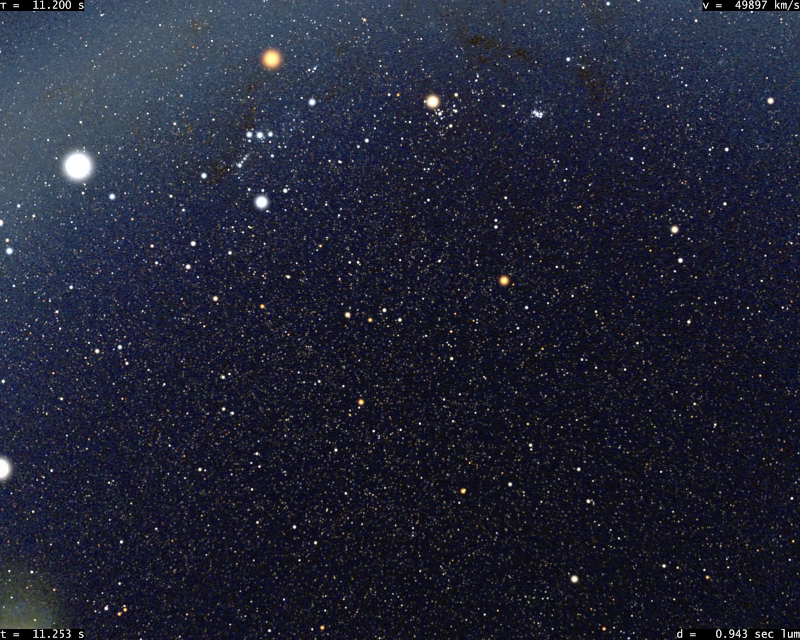
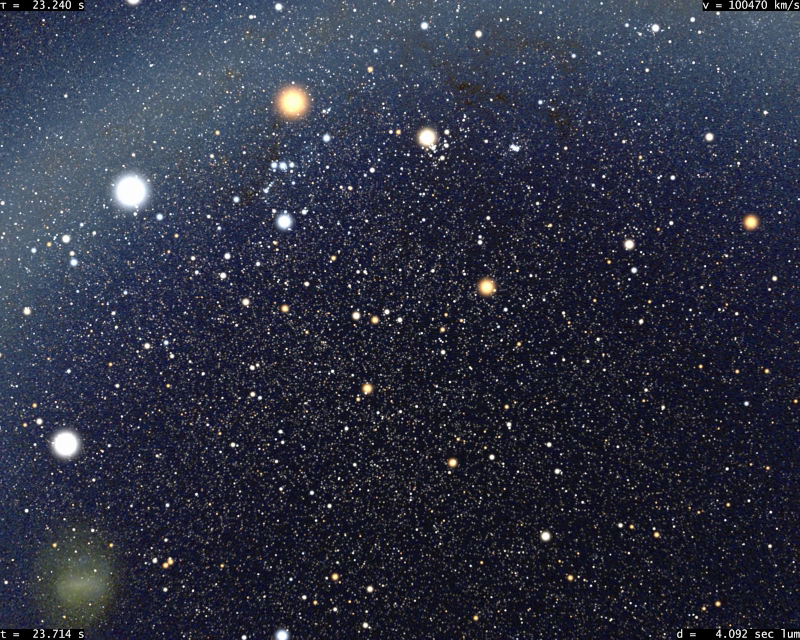 At one sixth and one third of the speed of light – click
to enlarge
At one sixth and one third of the speed of light – click
to enlarge

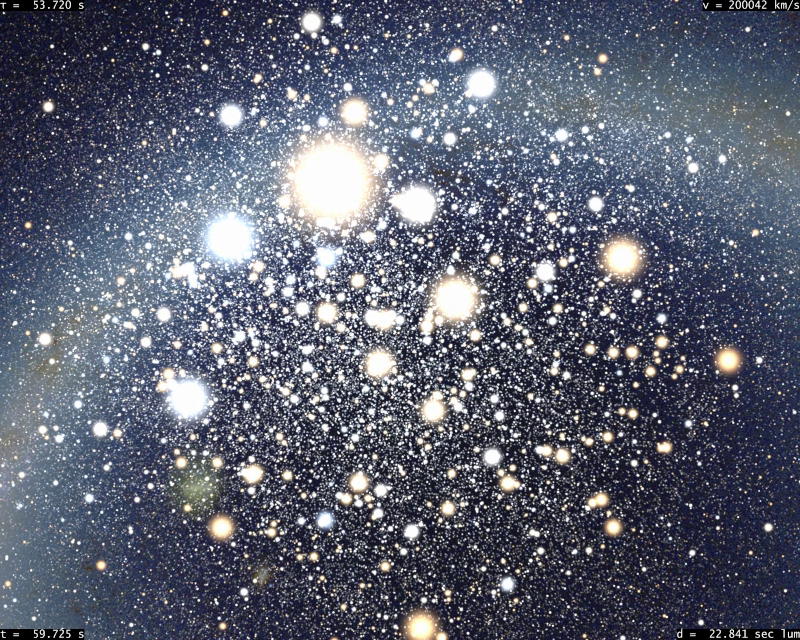 At one half and two thirds of the speed of light – click
to enlarge
At one half and two thirds of the speed of light – click
to enlarge
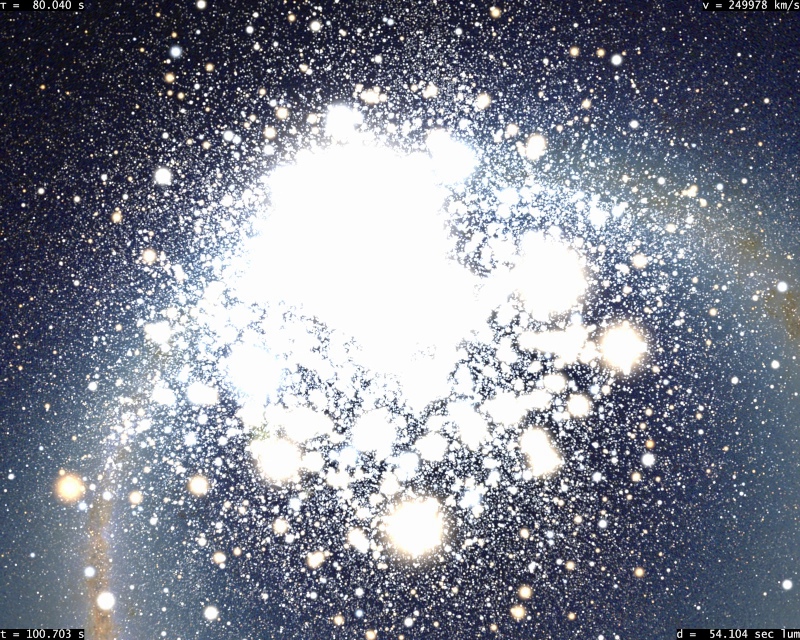
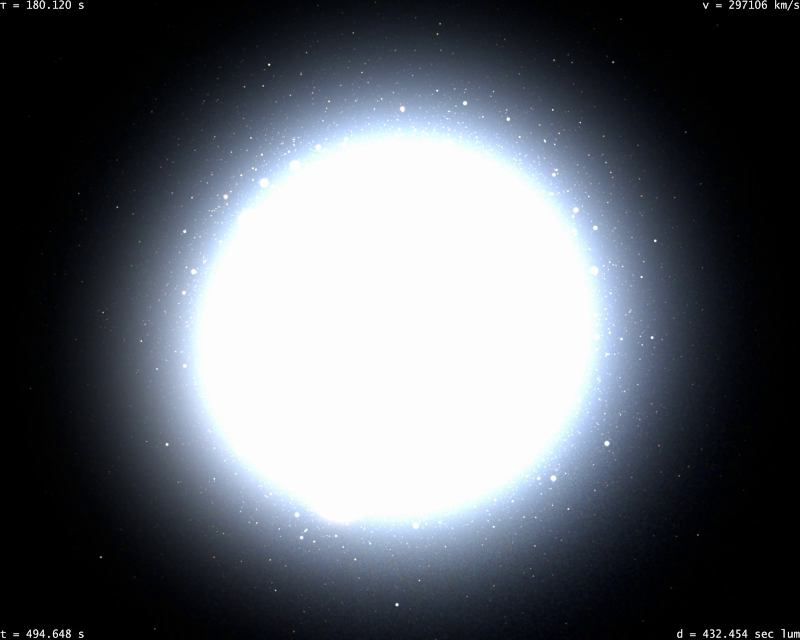 At 83% and 99.5% of the speed of light – click to
enlarge
At 83% and 99.5% of the speed of light – click to
enlarge
As you can check, the color change is far from being
the most spectacular feature one would see (should one
survive to the trip). So, should you experience this,
interstellar travel should look like:
- An acceleration phase, where the sky would fold into the
front direction, becoming there very bright, and very dim
elsewhere
- A travel phase, where almost nothing would notably change
from the boring bright spot of the last image
- A deceleration phase, where the celestial sphere would
unfold, thus revealing a possibly different sky than the one
at start in case you travelled far enough.
Want to see a video of the first phase? Click here (big file, ~150 Mb).
In the video, as well as on the above snapshot, there are a
few numbers. It is pretty easy to figure out what they mean.
Extreme gravity
A black hole is able to trap light in its
interior because of the extreme gravity it produces. But of
course, such gravity will also drastically affect its vicinity.
The most spectacular consequence of this is that light ray passing
close to a black hole will be deflected, possibly by a large
amount. If we imagine a black hole that appears in foreground of
some celestial sphere, then light ray originating from the
celestial sphere will be deflected on their way toward us. This
will introduce some significant distortion in the picture. For
example, compare the two following images:
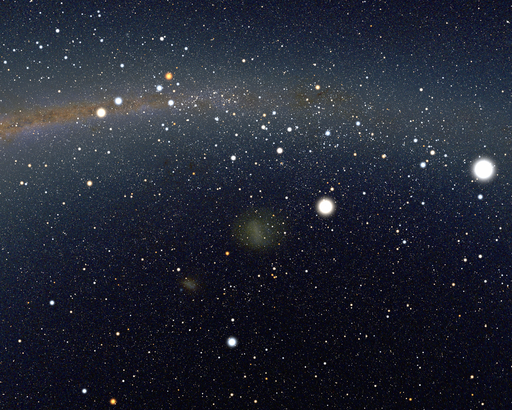
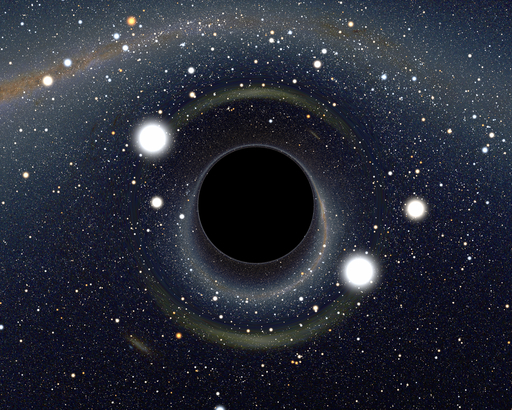
Click to enlarge to full resolution (2.5k x 2k)
They show how a region of the sky (around the
Large Magellanic Cloud in the southern hemisphere) is distorted by
the presence of a foreground black hole. What you should notice
after careful inspection is the following:
- Each star position has changed when we added the black hole.
They all tend to be pushed away from the direction toward which
we set the black hole.
- This position change goes together with some distortion for
extended objects such as the Large Magellanic Cloud.
- More importantly, any star now has a ghost image. The ghost
image is (almost) always dimmer than the primary image, and
closer to the black hole. The segment joining both images always
goes through the geometric center of the black hole silhouette.
- Most of the stars luminosity is unchanged, except for a few
ones which have a large increase in luminosity (as well as their ghost image). This corresponds
to stars which are close to being exactly behind the black hole.
Such phenomenon is the so-called gravitational lensing. Any
foreground celestial object can produce some gravitational
lensing, provided it is seen from a sufficiently large distance
so that the deflection of light it makes is larger than its
apparent diameter. Only black holes and possibly neutron star
can therefore make gravitational lensing when seen from such a
small distance.
If you want to have some extra information, you may be interested
in this
dedicated web page that was made a few years ago.
Combining both: orbiting around a black hole
Once you are familiar (more or less) with the
above, you can consider thinking to what happens if you orbit the
black hole, i.e., thinking to a non still version of last picture.
As you orbit the black hole, the stars that are exactly behind it
change all the time, and so does their luminosity and position.
The visual impression is that background stars somehow "dance"
around the black hole. Some people find it nice, and quite
relaxing. Let's hope it will be the same for you.
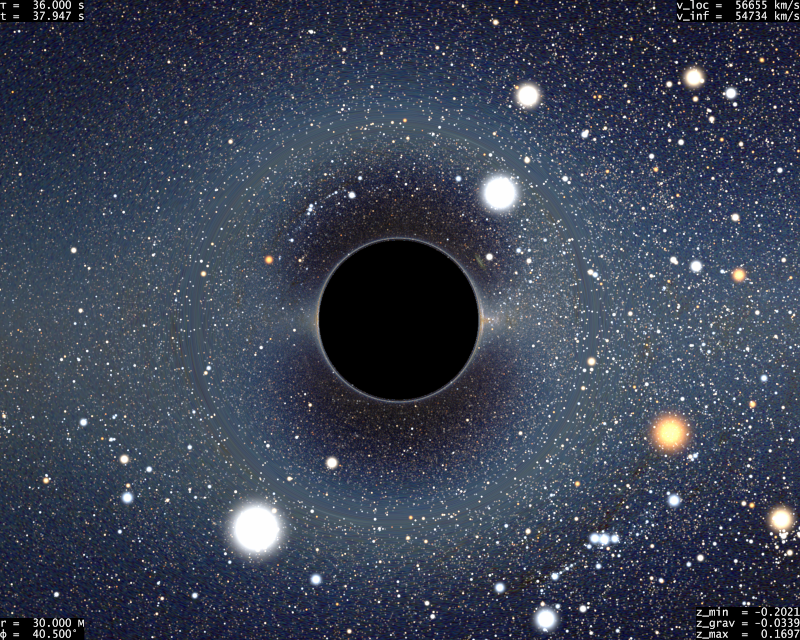
A snapshot of the movie you can download below (click to
enlarge).
Can you recognize a distorted Orion constellation and its even
more distorted secondary image? Red Betelgeuse is the key.
Download video
here
(WARNING, BIG file, ~400Mb!)
As shown on the screen, we are too far to the
black hole to go fast: we only cruise at less than 20% of the
speed of light, which is unambitious. What if we want to go
faster? It suffices to go closer to the black hole:
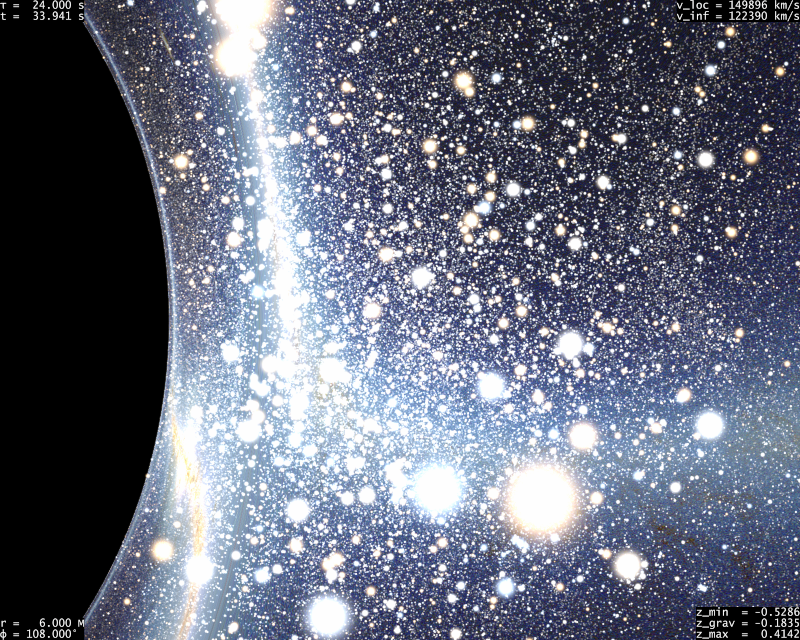 Cruising much closer to the black hole, at 50% of the
speed of light. Will you find Orion this time?
Cruising much closer to the black hole, at 50% of the
speed of light. Will you find Orion this time?
Download video
here
(warning, somewhat big file, ~140 Mb)
Several Black holes?
Just as stars often form binary systems, it is
possible that black hole binaries exist and originate from the
evolution of massive star binaries. In case the two black holes
are sufficiently close to each other, then some interesting
phenomena occur. Unfortunately, an exact description of a close
black hole binary gravitational field is one of the most
challenging problem gravitational physics, so that some
approximations have to be done here. The simplest one consists in
considering non rotating, electrically charged black holes. If
their electric charge is of same sign, then it is possible to tune
it so as the gravitational attraction is exactly counterbalanced
by electrostatic repulsion. Such a pair of black hole cannot form
a binary system since they cannot orbit around each others, but
one can at least have a sketch of the combined set of distortion a
pair of black hole produces. Below we show what an observer at
rest would see when looking at a close pair of black hole that
would be moved with respect to each other by non gravitational
forces, thus mimicking a pseudo-orbital motion. We expect to see
the silhouette of both black hole. But forgetting the nature of a
given black hole, we also expect to see the distorted ghost image of its
silhouette because of the presence of the second black hole, and
vice-versa. So we should see actually four black hole silhouettes.
Can you spot them below?
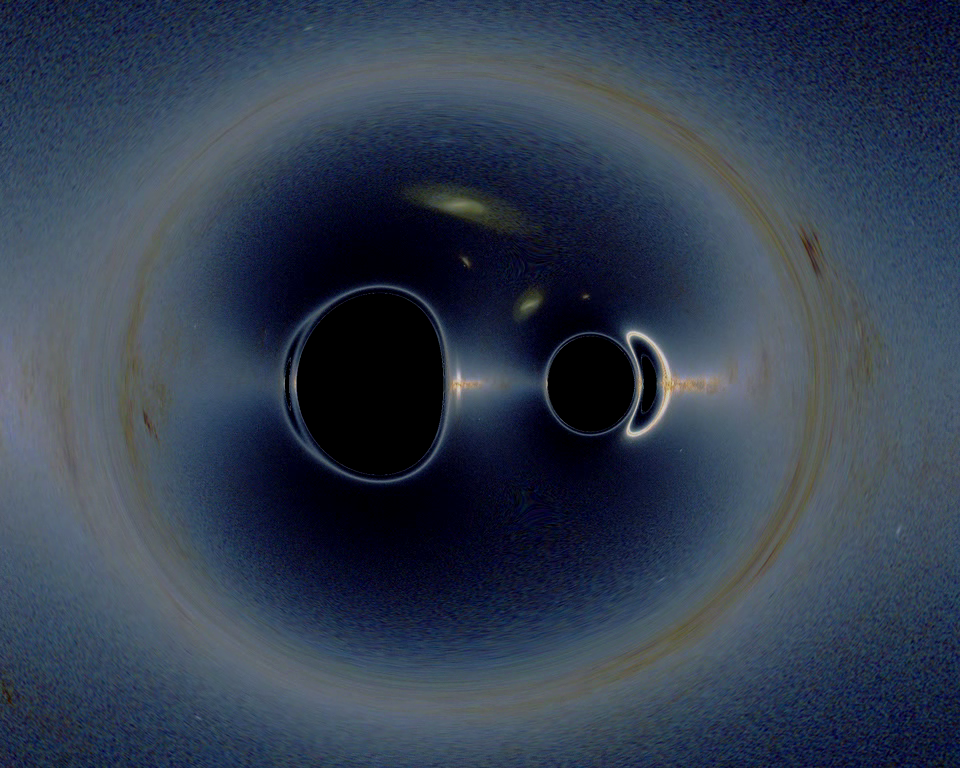
There is a big black hole to the left, and a small black hole to
the right. To the left of the big black hole, one sees the
banana-shaped secondary image of the small black hole. And to
the right of the small black hole, we see the bean shaped
secondary image of the big black hole. That's still easy...
Now, what happens if the small black hole goes behind the bigger
one? As we saw, a point like object is scattered on a shell
around the foreground black hole. So it happens here!
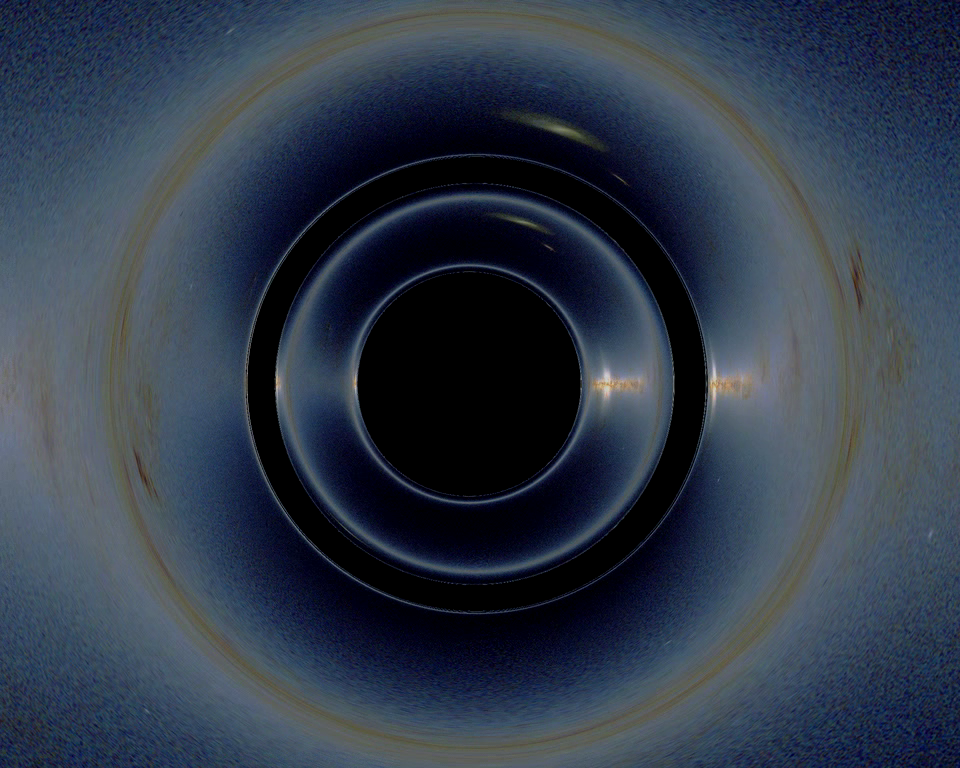
And of course, we can also put the small
black hole in front of the big one:
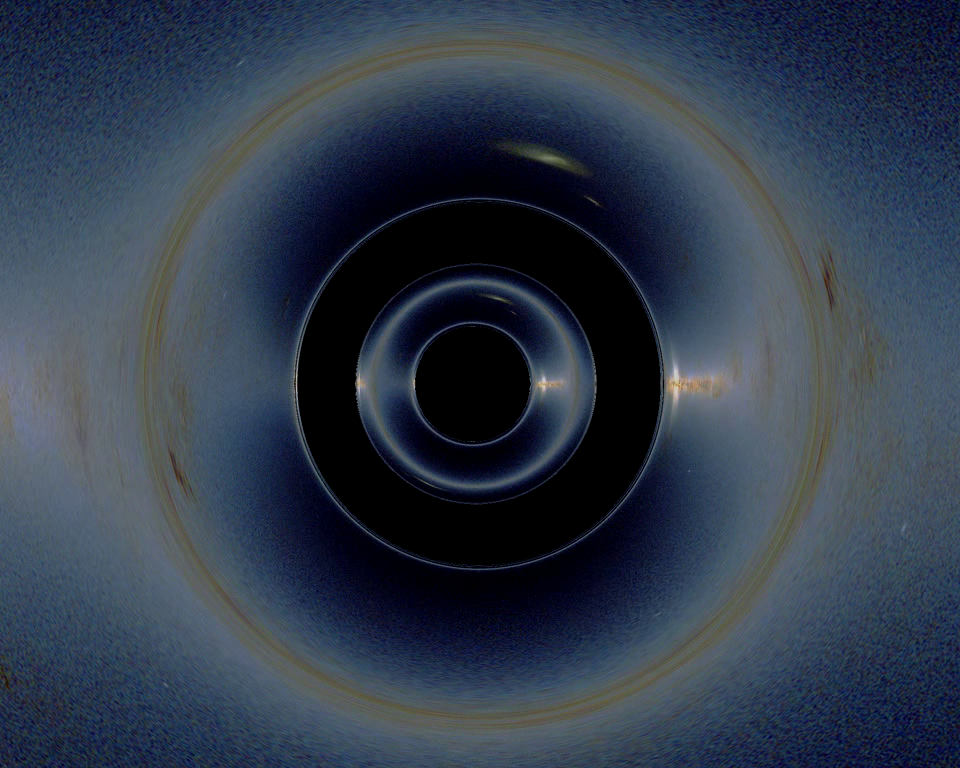
The shell, aka the big black hole, is
thicker than in the previous case, which should sound logical if you are not too
confused. When the black hole are aligned with the
observer, we now only see one image of each instead of
two. So, what soes it look like if we make a movie of
this? Click
here. But
for what reason could one be interested in lookisng at
combined distortions made by a black hole pair? Saying more could make this webpage
non spoiler free, so let us say that part of
the answer lies in M. Thorne's book,
The Science of
Interstellar.
Last modified 7
November 2014


